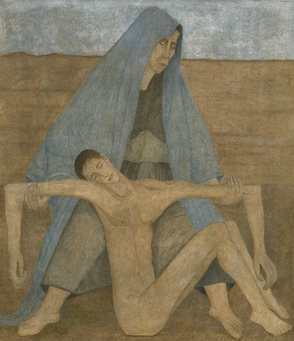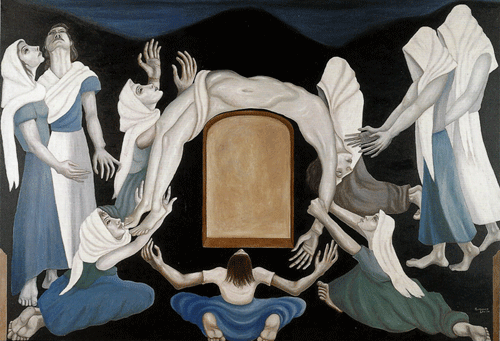Source: WTL photographs© at the Special Exhibition of "Paint the Revolution: Mexican Modernism 1910 - 1950," at the Philadelphia Art Museum, December 13, 2016.
Images:
The work on the left is large 8 feet by 7 feet fresco, "Pietà in the Desert" (1942), which Manuel Rodríguez Lozano first created in the Mexican high security Lecumberri prison (it was later removed). The work on the right, also by Rodríguez Lozano, is the oil on canvas painting "The Holocaust" (1944).
Comments: These two paintings are signs that, in the decade of the 1940s some Mexican artists--Rodríguez Lozano is a prime example along with María Izquierdo and others--were beginning to focus their concerns on themes less directly related to the Mexican Revolution. Art critic Adrián Figueroa, for example, called him a "sadly restrained artist [un artista dolorasamente templado]" and another, Judith Amador Tello, in 2011, styled him as "the artist of a people's pain [el pintor del dolor del pueblo]." Both of these works, created during World War II, certainly communicate human suffering and pain with religious themes. "Pietà in the Desert" uses the traditional Catholic Crucifixion scene of Jesus' mother Mary cradling her dead Son in her lap when his body was removed from the cross to illustrate deep suffering. Likewise, "The Holocaust" uses a dramatic chiaroscuro (light and dark contrast) and that notion of the World War II Holocaust when the Nazis killed 6,000,000 Jews in the infamous death camps to illustrate extreme human despair. The tan image in the center of the canvas appears either to represent either a cemetery headstone or one of the Jewish tablets of the Ten Commandments from which the words have been erased or have disappeared. Rodríguez Lozano had an eventful life and a very successful career. After studying at the famous Academy of San Carlos, he, who was bisexual, married Carmen Mondragón, known as Nahui Ollín. (For Dr. Atl's portrait of Nahui Ollin, see: <= Pages #8.) They had a son who died tragically, but since her father, General Manuel Mondragón, was involved in the assassination of President Francisco I. Madero (1913), this extended family lived in exile until 1921. In Paris, Rodríguez Lozano associated with famous artists of the period including Matisse, Braque, Picasso, and many others. In Mexico he associated with many famous artists and intellectuals including the composer Carlos Chávez, Diego Rivera, the photographer Manuel Álvarez Bravo, the philosopher Alfonso Reyes, the actress Dolores del Río, the playwright Rodolfo Usigli, and even Nelson Rockefeller. In the 1920s he fell in love with his art student Abraham Ángel (1905-24), who, tragically died from a drug overdose, which was possibly suicide.
Humanities Question: Compare and contrast these two works of art.




